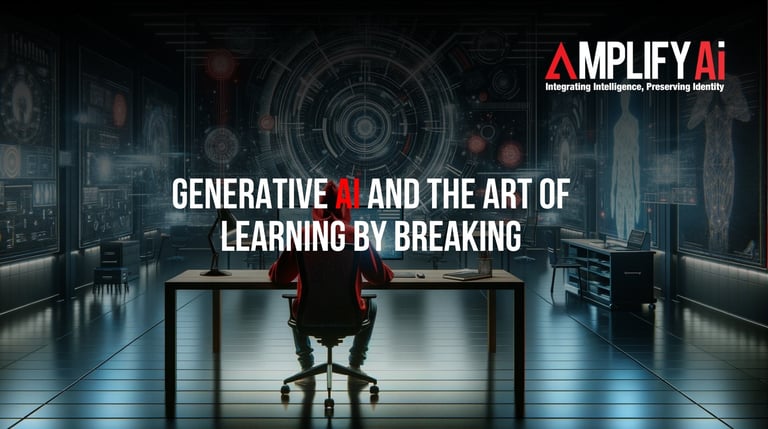Generative AI and the Art of Learning by Breaking
Ronsley Vaz
3 min read


The emergence of Generative AI marks not only a significant advancement in technological innovation but also signifies a fundamental change in our approach towards learning, creativity, and problem-solving. This transformative shift ushers in a new era where the concept of learning by breaking transcends traditional methods, becoming a foundational philosophy. It advocates for a proactive, hands-on, and iterative exploration to deeply understand and effectively harness the vast capabilities of artificial intelligence.
The Rise of Generative AI
Generative AI encompasses sophisticated algorithms capable of creating entirely new content, including text, images, music, and code, by identifying and applying patterns from extensive datasets. Championed by models such as the Generative Pretrained Transformer (GPT), this groundbreaking technology has ignited a revolution across a spectrum of industries, ranging from the creative arts to software development. It presents tools that significantly augment human capabilities, enabling levels of creativity and efficiency previously unattainable.
The Process of AI Development
The journey of Generative AI development is characterised by an iterative process. Developers painstakingly train these models on comprehensive datasets, followed by a rigorous cycle of testing, refining, and retesting. This iterative cycle—comprising construction, deconstruction, and reconstruction—is indispensable for propelling AI technology forward. It ensures that Generative AI can achieve its intended objectives with optimal accuracy, creativity, and utility, all the while adhering to ethical standards.
AI in Creative Industries
Generative AI has emerged as a frontier of innovation for artists, writers, musicians, and other creative industries. It offers groundbreaking tools capable of producing original creations or enhancing existing works with novel variations and improvements. By dissecting and reimagining the creative process, Generative AI empowers artists to venture into uncharted territories, challenging and expanding the confines of traditional artistic expression.
The Art of Learning by Breaking
The concept of learning by breaking with Generative AI carries profound educational implications. It enables students and professionals to interact with AI tools for problem-solving, ideation, or comprehension of complex concepts through an experiential, trial-and-error learning approach. This methodology not only cultivates a deeper understanding of AI technology but also fosters critical thinking, innovation, and a robust problem-solving mindset.
At the heart of Generative AI's development and application lies in learning by breaking. This involves a deliberate process of pushing the AI systems to their limits, deconstructing their operational mechanisms, and challenging their capacities to unveil their utmost potential and boundaries. Such a hands-on, explorative approach is crucial for innovators, developers, and end-users alike, enabling them to grasp the intricacies and nuances of these sophisticated systems.
To really make the most of Generative AI, it's important to be curious, try new things, and keep going even when things get tough. This means being ready to break down and build up our understanding of technology and how we can use it in different ways. We have to keep trying new stuff and pushing what we know to find new ideas and ways of doing things.
Ethical Considerations in Generative AI
The ascent of Generative AI, while promising, is accompanied by significant ethical considerations. The spectrum of concerns includes data privacy, potential copyright violations, and the risks of misuse. Addressing these ethical dilemmas is paramount to harnessing Generative AI's benefits responsibly, ensuring that its advancements do not come at the cost of compromising moral principles or societal norms.
The Role of Transparency and Regulation
Achieving ethical integrity in Generative AI necessitates transparency regarding the training methodologies and output generation processes of AI models. Concurrently, the establishment and enforcement of regulatory frameworks are critical for ensuring that AI technologies are utilised in a manner that upholds fairness, accountability, and respect for individual privacy and intellectual property rights.
The Future of Generative AI
The horizon for Generative AI applications is expansive and diverse, promising to revolutionise educational methodologies, design processes, and beyond. It holds the potential to significantly enhance human creativity and problem-solving capabilities across numerous domains. Realising this potential, however, demands continuous dialogue and collaboration among developers, users, and regulatory bodies to adeptly navigate the ethical, technical, and societal challenges that accompany such advancements.
Generative AI and the art of learning by breaking represent a significant shift in our relationship with technology. By embracing this approach, we can unlock the full potential of AI to augment human creativity and intelligence, driving innovation and progress across all areas of society. However, as we venture into this new territory, it is imperative that we remain mindful of the ethical implications, ensuring that our journey with AI is guided by principles of responsibility, equity, and respect for all.
In this exciting era of digital transformation, the art of learning by breaking stands as a testament to human ingenuity and the endless possibilities that await us when we are willing to explore, experiment, and learn. As we continue to navigate the complexities of Generative AI, let us do so with an open mind, a spirit of inquiry, and a commitment to ethical and sustainable development.
Subscribe to the podcast
Subscribe now to "Amplify Ai" and let's set sail together on this exciting voyage towards business growth and success.



